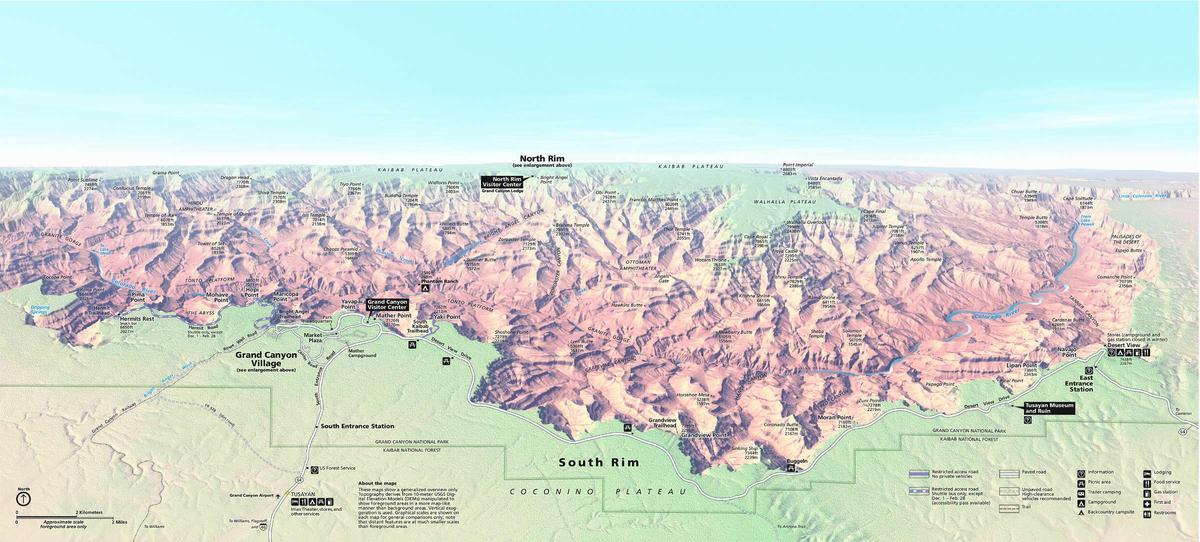Grand Canyon NP--Bright Angel Lodge
Grand Canyon NP--Bright Angel Lodge
Grand Canyon, Arizona 86023
Bright Angel Lodge websiteDay Hiking - Grand Canyon National Park
Grand Canyon National Park website
Grand Canyon National Park maps
Tips for Birding
In-depth information is found on the Grand Canyon National Park website.
About this Location
Bright Angel Lodge, designed in 1935 by famed Southwest architect Mary E.J. Colter, has a natural rustic character and is a Registered National Historic Landmark. This iconic lodge and its surrounding cabins are rich with cultural history. Over the years it has gone through many transformations – originally a hotel, then a camp, and finally a lodge. All of its changes were to accommodate increased visitation after the arrival of the train in 1901. Under the direction of the Santa Fe Railroad, Colter was tasked to design a fresh look for Bright Angel Lodge in an effort to provide more moderately priced lodging in contrast to El Tovar “up the hill.” She drew inspiration from many local sources in her architecture. For example, the ”geologic” fireplace in the History Room features all of the rock layers of the Grand Canyon, from the river cobbles to the youngest stone strata on the rim. Included in this lodge design were a couple of historically significant structures that might well have been demolished without her intervention – the Buckey O’Neill Cabin, originally home to one of Roosevelt’s Rough Riders, and the Red Horse Station, which served as the post office for 20 years. Both are currently available as overnight accommodations.
Visit the Bright Angel History Room where you will find information on the Harvey Girls, the Harvey Indian Detour Couriers, historic postcards, a 100-year-old El Tovar menu, an original surrey carriage, and much more.
Today, the Bright Angel Lodge and surrounding cabins serve as an iconic remembrance of its colorful past. Located at the top of Bright Angel Trail Head, the facility sees visitors from all around the world. Bright Angel Lodge also features Fred Harvey Burger, a family-friendly restaurant serving diner classics prepared in the Fred Harvey tradition from huevos rancheros to gourmet burgers and fajitas. Fred Harvey Burger is open for breakfast, lunch, and dinner. Another option is the Arizona Steakhouse featuring steaks, chicken, and ribs prepared with the flavors of Arizona and the Southwest. Open seasonally, visit the old-fashioned ice-cream Soda Fountain just steps from the rim. There is also a gift shop, coffee house, and old-style saloon.
About Grand Canyon National Park
See all hotspots at Grand Canyon National Park
Grand Canyon is considered one of the finest examples of arid-land erosion in the world. Incised by the Colorado River, the canyon is immense, averaging 4,000 feet deep for its entire 277 miles. It is 6,000 feet deep at its deepest point and 18 miles at its widest. However, the significance of Grand Canyon is not limited to its geology.
The Park contains several major ecosystems. Its great biological diversity can be attributed to the presence of five of the seven life zones and three of the four desert types in North America.
The five life zones represented are the Lower Sonoran, Upper Sonoran, Transition, Canadian, and Hudsonian. This is equivalent to traveling from Mexico to Canada.
The Park also serves as an ecological refuge, with relatively undisturbed remnants of dwindling ecosystems (such as boreal forest and desert riparian communities). It is home to numerous rare, endemic (found only at Grand Canyon), and specially protected (threatened or endangered) plant and animal species.
Over 1,500 plant, 355 bird, 89 mammalian, 47 reptile, 9 amphibian, and 17 fish species are found in the park.
Notable Trails
Many options are available for day hikers. Both the South Rim and the North Rim offer rim trail hikes that have spectacular views of the inner canyon, some on paved trails. Or you can choose to day hike into the canyon. Permits are not required for non-commercial day hikes.
Content from Bright Angel Lodge website, Day Hiking - Grand Canyon National Park, and Grand Canyon National Park website
 Grand Canyon Panorama Map
Grand Canyon Panorama Map